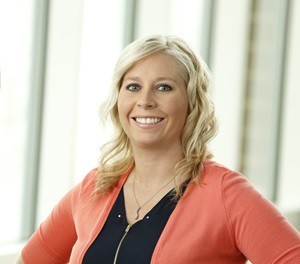Rachel Muench has one message for you: “There’s hope.”
She injured herself one morning last fall, twisting at an odd angle to replace a hard-to-reach battery in a smoke detector. Moments later, she felt a stabbing pain in her back—so strong it brought her to her knees. She headed into work anyway and tried to push through the pain, but six hours later her legs had started to go numb.
By 4:30 that afternoon, she was losing the ability to walk and the doctor at her local walk-in clinic told her to go straight to Aurora BayCare’s ER in Green Bay. By the time she arrived, her right leg was completely paralyzed and she was losing all strength in her left leg and her core. That evening, Rachel was in intensive care.
The prognosis: A rare neurological condition called Brown-Sequard Syndrome caused by a spinal cord stroke. Over the next few days, additional tests revealed that Rachel had bulging disc in her spine, and fragments were blocking a blood vessel that fed her spinal cord.
Dr. James Napier, the neurologist treating Rachel, says he typically sees only two cases of Brown-Sequard a year, most often in older men. Rachel, though, was an active 30-year-old.
She remembers those first few days, trying to absorb what was happening. “The condition is so rare, no one could tell me not to worry. No one knew,” she says. “But I understood I might never walk again.”
Small Goals, Big Progress
Not surprisingly, Rachel and her family started to do their research. “The best information we could find, which Dr. Napier supported, was that somewhere between 11 percent to 50 percent of patients regain the functional ability to walk,” Rachel says. “And that just means you’re using a walker or double canes.”
But Rachel was young and healthy and, perhaps most importantly, a competitive person. After transferring to Aurora BayCare’s inpatient rehab, she was determined to get back as much function as she could, constantly challenging herself to meet new goals.
“My right leg was paralyzed for 10 days before it started to move,” she says. “But once that started, every day something big happened. Dr. Guo would come in and say, ‘Show me what’s new today. Show me your tricks.’”
Twenty-five days after her arrival in the hospital, Rachel was discharged from rehab—a full 10 days ahead of schedule.
“I’m pretty sure they thought they’d be fitting me for a wheelchair before I left, but I walked out on my own, using a walker,” Rachel reports.
Reconciling to a New Normal
She’s still not back to full mobility and probably never will be. Because of nerve damage, she has near constant pain in her legs combined with a loss of sensation in her left leg and her feet. And if she tries to move quickly, her muscles go rigid.
But she can walk unassisted, without a cane. A waitress before her accident, Rachel is trying to get back to work—building up her strength with one limited lunch shift a week. She and her husband still went on their planned trip to Vegas (six weeks after injury), and she just took on care of a new puppy who she’s training to be a pet therapy dog.
“I’m not who I’m used to be. I’m learning to operate with my new normal,” she says. “But compared to what I thought it was going to be…it’s perfect.”
And that’s what she wants other people with Brown-Sequard Syndrome or a spinal cord stroke to know.
“I want them to look at me and push themselves. I want them to keep going,” she says. “I want them to stay positive.”
Watch the Health Watch segment featuring Rachel and Dr. Napier and learn more about Aurora BayCare's neuroscience care.
